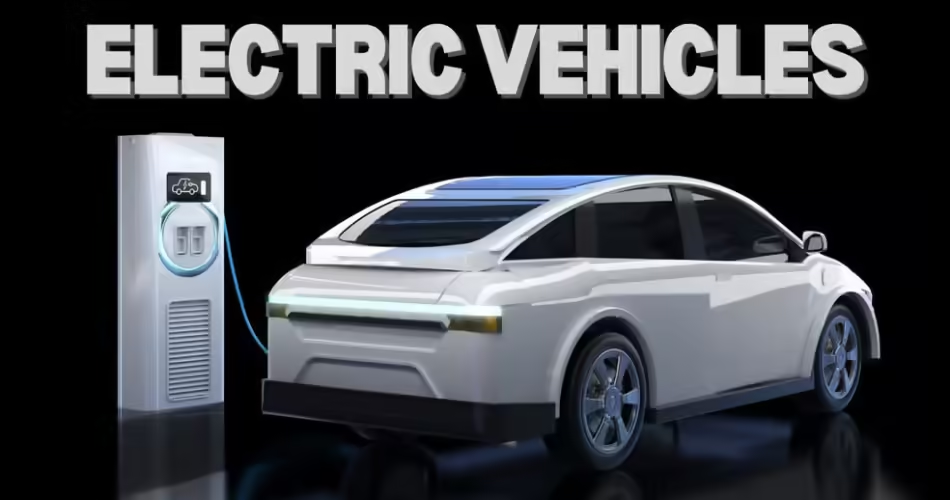This blog provides information about Electric Vehicles. In the start, it tells what is an Electric Vehicle. Then it explains why is it needed in our lives. It also mentions the Types of Electric Vehicles in detail. It also elaborates the Advantages and Disadvantages of Electric Vehicles in detail. In the end, it provides some information about the Countries using Electric Vehicles in bulk. This blog contains Needs, Types, Advantages and Disadvantages of Electric Vehicles.
What are Electric Vehicles?
Electric Vehicles can be defined as a vehicle that can be powered by an electric motor that draws electricity from a battery and can be charged by an external source. These vehicles include road and rail vehicles, water boats, electric aircrafts and electric space crafts.
Electric vehicles are energy consuming vehicles but they do not consume any type of fuel or any non-renewable resource. It can be charged electricity and can work from hours to days. They are easy to use and maintain than other traditional vehicles.
Need of Electric Vehicles:
As we all know that traditional vehicles emits major air pollutants and are deteriorating the quality of air globally. They are the major source of air pollution all over the world. The reason is that they have combustion engines in them that burn fuel whenever they are used. Electric vehicles on the other hand provide us opportunity to drive our vehicle only with the help of electricity with a help of a charger. Just as we charge our smartphones and use them throughout the day without any worry. In this way burning of fuel and other internal maintenance of the cars is eliminated.
Due to the increasing air pollution and disturbance in the Air Quality Index (AQI), it the need of the time to switch to Electrical Vehicles in place of traditional vehicles. Electrical Vehicles facilitates us and the Global Warming and Climate Change in many ways.

BMW i3 Electric Vehicles
Types of Electric Vehicles:
Electric vehicles are of four types according to their system and technology. These four types are below:
Battery Electric Vehicles:
Battery Electric Vehicles or BEVs are the most common type of Electric Vehicles. These vehicles are fully electric and with no gasoline engine. These vehicles have rechargeable batteries. All energy comes from the battery pack which recharges from the grid. These are zero emission vehicles so they are a great weapon to fight with air pollution and global warming. Some of them are fast charging vehicles and some have average charging speed.
Plug-in Hybrid Electric Vehicles:
Plug-in Hybrid Electric Vehicles or PHEV have both an engine, and an electric battery to drive a car. They differ from ordinary hybrid vehicles because they have a much larger battery, and being able to plug in into the grid and recharge while other hybrid vehicles do not have this feature. The Hybrid vehicles can drive 1 to 2 miles until the gasoline engine starts, PHEVs can drive for 10 to 40 miles before the gasoline engine starts. After the electric range, they converts into gasoline vehicles. By driving into the limits, we can use it as an electric car with zero emissions.
Hybrid Electric Vehicles:
Hybrid Electric Vehicles or HEVs have both electric motor and gasoline engine. All energy is gained through regenerative braking. HEVs combines with the benefits of high fuel economy and low tailpipe emissions. HEVs are more expensive than similar conventional vehicles. Some cost recovers from fuel saving or state incentives. These vehicles drives by internal combustion engines in combination with one or two electric motors. In this way it saves fuel.
Fuel Cell Electric Vehicles:
Fuel Cell Electric Vehicles or FCEVs are powered by hydrogen. These vehicles are much more efficient than conventional vehicles as they do not emit harmful gases, they just emit water vapors and warm air. The FCEVs are in the initial stages of implementation. Research says that hydrogen-powered vehicles will be affordable, environmentally friendly and a safe transportation. Because hydrogen is consider as the best alternative energy in the coming era as it is present in the environment in bulk quantities and is safe to use. This will be a great success after implementation.

Tesla Electric Vehicles
Advantages and Disadvantages of Electric Vehicles:
Advantages of EVs:
Following are some advantages of Electric Vehicles:
- EVs cause zero emissions and so are environmentally friendly.
- EVs have fewer moving parts than combustion engine vehicles.
- They posses quiet operation that is easier than other vehicles.
- EVs have fewer fossil fuel dependence.
- EVs develop quick acceleration and provide responsive driving experience.
These are the advantages of Electric Vehicles.
Disadvantages of EVs:
Following are the disadvantages of Electric Vehicles:
- EVs have limited driving range than other vehicles.
- EVs have lack of charging infrastructure.
- EV’s battery degrades with time and so it can be less efficient with time.
- EVs need long charging time to get fully charge.
- EVs have higher upfront cost than other vehicles.
These were the disadvantages of Electric Vehicles.
Countries Taking Advantage from Electric Vehicles:
Electric Vehicles are the best solution to avoid Environmental Problems and Climate Change on Earth. Because most of the GHG emissions are from Transportation and Conventional Vehicles. Some of the countries of the world have taken this concern very seriously and they are implementing the Electric Vehicle Technology in accessible ways in a very short time. Following are the Countries with fastest sales and implementation of Electric Vehicles:
- Norway
- Iceland
- Netherlands
- China
- Sweden etc.
These are some of the top Countries that are producing and using Electric Vehicles in the world as well as reducing their Carbon Footprint and Impacts of Climate Change. Norway is at the stop in the context of Sales of Electric Vehicles. Every country should work as Norway takes advantage of Electric Vehicles. In all of these countries, when 1% EV sales reached, they got Accelerated. In this way, the countries who are Working on the Production of New Technologies of Electric Vehicles are contributing the reducing the Global Warming, Air Pollution and Climate Change.

To learn about more topics, Click the links below:


Comments